Focusing on infrastructure this week, The Verge published an article Monday about broadband distribution in the U.S., providing a tidy map denoting which counties are not adequately served by high-speed internet.
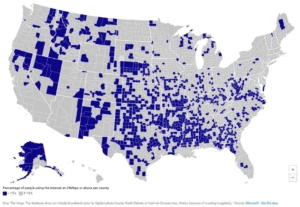
Do you see what I see? Because it looks really familiar, kind of like this somewhat more granular map published in USAToday:
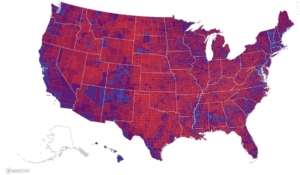
There are exceptions to my theory, but on the face of it there’s a correlation in most states between broadband access and so-called conservative voters.
Look at these two excerpts side by side:
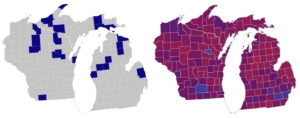
There may be another corollary, at least in Michigan: the areas with crappy to nonexistent broadband are the ones which were hardest hit by the third wave COVID because there are more anti-mask, anti-lockdown, ‘COVID’s a hoax’ residents on average. Here’s NYT’s national map of COVID hot spots from April 9 (sorry, I didn’t get a zoomed-in image of WI-MI at that time):
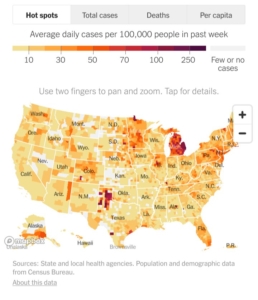
Wisconsin is not as obvious a challenge in this map but the lack of broadband and red voters correlates to COVID hot spot region in north Texas.
This map, published by State of Michigan a few weeks earlier into Michigan’s third wave COVID cases, also shows the correlation:
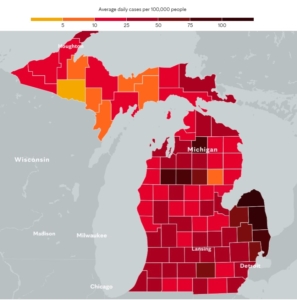
While there are some exceptions like Marquette and Keweenaw Counties (both of which may have been affected by student and faculty populations in state universities) in the Upper Peninsula, the hot spots tracked from March into May the areas with low broadband and red voters.
Do note the one small outlier county near the middle of Wisconsin — that’s Menominee County, which voted blue but has crappy broadband. It’s the least populated of all counties in the state but its roughly 4550 residents are more than 87% Native American. Which means there’s not enough profit for broadband providers, and no ethics or adequate legislation at either state or federal level obligating coverage.
This week’s map of vaccination uptake in Michigan as published by Mlive shows the effect of anti-vaxx disinformation. In spite of horrific case counts, hospitalizations, and deaths in the low broadband Trump-voting areas, vaccine uptake has been slow.
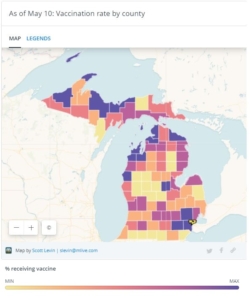
Note the yellow county at the right of the map along Lake Huron; this is in MI-10, an area so pro-Trump that its previous congressional representative retired rather than run for re-election. Also not served adequately by broadband. (Also ripe for manipulation by outside parties like banking and real estate investors; it’s through this county that the new pipeline for water from Lake Huron to Flint was run at considerable expense and time, in spite of the proximity to Saginaw’s water system to the north and Detroit’s to the south.)
Another layer to this onion is the lack of print news media, shown on this Knight Foundation national map:
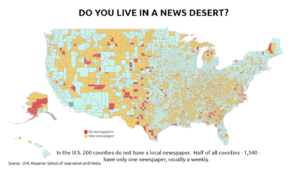
While that Trump-voting Michigan county of Sanilac on Lake Huron has print media, there’s a correlation between other counties without adequate broadband and low vaccine uptake.
I can’t find a decent map showing broadcast TV and radio coverage but some of the same problematic counties are underserved — most definitely in Michigan’s Upper Peninsula and the upper portion of Wisconsin. There are concerns about how much of the state is served by Sinclair-owned television stations; they’re not as bad as Fox, but Sinclair owns far too much opportunity to push right-wing friendly content over publicly-owned airwaves.
Granted, there are some additional factors which shape the ideology espoused by persons who are slow to accept vaccination and reject masks. Some of these counties are extremely non-diverse, by which I mean more than 96% non-Hispanic white. Some are more than 55% male.
At least one of the counties in Michigan’s UP leans the other way because its population is older. Ontonagon County’s median age is 52.7 years while Sanilac’s median age is 43.
All of this is to say that the lack of broadband infrastructure serving Americans uniformly leaves them prey to disinformation about existential matters. If they aren’t getting information from a variety of media served up by broadband, AND they don’t have ready access to print media, AND they are likely underserved by broadcasters, they are ripe for whatever media is easiest to access including Facebook and other social media platforms on their cell phones.
~ ~ ~
Now here’s where it gets personal.
I have a family member who lives in a broadband desert, in a Trump-voting rural county. I thought of them immediately when Marcy wrote Radicalized by Trump: A Tale of Two Assault Defendants last week. This family member has written some things my kids won’t share with me (I’m not on Facebook and they are) because what this person has shared is so Trumpy and Qultish.
One of the two defendants Marcy wrote about blamed “Foxitis” for their radicalization. This isn’t the case for this family member because they live in a broadband desert. They may get digital broadcast but this means they aren’t exposed to Fox programming on cable. They don’t have cable, DSL, or wireless internet, only the data they purchase with their cell phone service.
This family member isn’t getting the newspaper, either; they’re not stupid but they’ve never been much of a reader.
Whatever is rotting their brain is coming through their phone, and my kids already know Facebook is one of the social media outlets this family member uses.
Fortunately this same family member isn’t prone to activism and has enough demands on their personal time that they aren’t likely to take off and go to rallies with other Trumpers and Qultists.
But we’re still looking at someone who views any messaging from the state government under Governor Whitmer and the federal government under President Biden with great suspicion and skepticism, to the point where they may resist measures intended to protect them, their family, and their community. The only information they’re getting about either state or federal government is through the filter of their limited social media.
I’m afraid this person’s mind won’t change until they have access to a lot more information from a much broader range of sources. Until they have cheap and easily accessible broadband, they’re going to be lost to disinformation and at continued risk.
This is bad enough — a family member who lives a couple hours away who I’ll have to write off as inaccessible for the near term because they have been poisoned by disinfo.
But this disinfo poisoning managed to affect my household directly.
Friends who are in agriculture suggested purchasing a side of beef soon as they expect meat prices to go up over the next few months. They recommended a processor in one of the counties which was hit hard by the third wave — a processor from whom we haven’t purchased before.
I suggested to my spouse that we try a processor up north who we’ve used in the past. They live in a very rural county which has fared a little better, and we’ve always liked their service.
When my spouse looked into placing an order, he was told they’d just lost two personnel who died of COVID and orders were backlogged.
How the heck do people who process meat for a country store in a county of less than 15,000 people end up dead of COVID?
What else may be hurting, possibly killing these people for lack of adequate, rational information?
I can’t be certain of anything except for not buying my beef there any time soon, and that country store’s location in a county indicated by blue denoting a lack of broadband.
 Will not be overly long on this, but have been saddened and fascinated with the Champlain collapse in Miami since news of it first surfaced. Here is a New York Times report. Here is an absolutely harrowing tick tock, with video and photos, from The Washington Post. Seriously, make sure to look at the WaPo piece.
Will not be overly long on this, but have been saddened and fascinated with the Champlain collapse in Miami since news of it first surfaced. Here is a New York Times report. Here is an absolutely harrowing tick tock, with video and photos, from The Washington Post. Seriously, make sure to look at the WaPo piece.

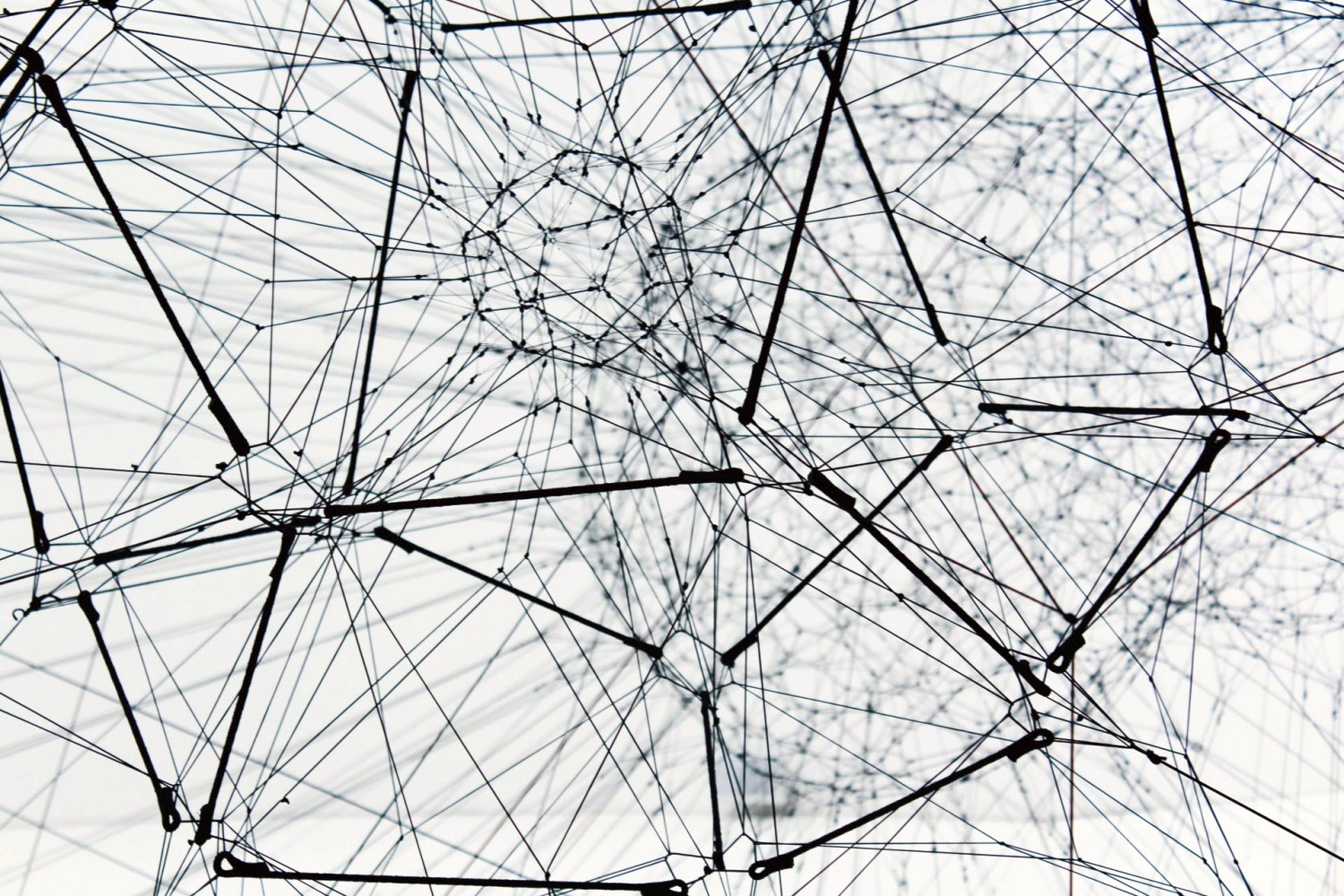







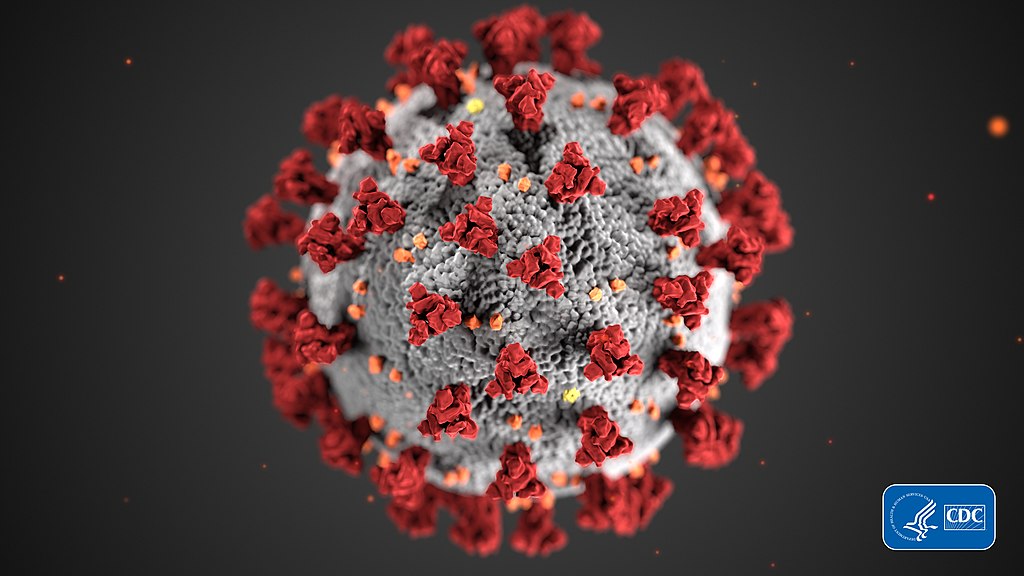


![[Photo by Piron Guillaume via Unsplash]](https://www.emptywheel.net/wp-content/uploads/2017/07/Healthcare_PironGuillaume-Unsplash_v1.jpg)


![[source: Google Finance]](https://www.emptywheel.net/wp-content/uploads/2017/08/Screenshot_GoogleFin-TrumpNK_09AUG2017-300x163.jpg)


